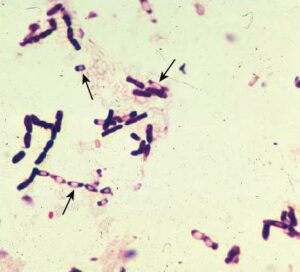Introduction of botulism
- Botulism is an intoxication caused by neurotoxins produced by Clostridium botulinum, which adversely affects the synapses of the peripheral nervous system.
- Botulinum is considered as most potent poison in the world.
- Clinically, three types of manifestation of botulism are recognized – food-borne botulism, infant botulism, and wound botulism.
Etiology Agent
- The etiology agent of botulism is Clostridium botulinum, a fastidious, anaerobic, and spore-forming rod.

- It is divided into four groups based on genetic and phenotypic properties.
- Seven antigenic distinct botulinum toxins [A to G] have been recognized, basically, types A, B, E and F are associated with human diseases.
- Other species of clostridia produce botulinum toxins, including C. butyricum [E- type], C. baratii [type F toxin], rarely associated with human disease, and C. argentinense [G- type toxin].
Pathogenicity and Virulence factors of botulinum
- Clostridium botulinum toxin is made up of 150,000 Da progenitor protein (A-B toxins).
- Consists of a small subunit (light or A chain) with zinc- endopeptidase activity and large subunit B is nontoxic.
- The toxin forms a complex with nontoxic proteins that protect neurotoxins during the passage through the digestive tract.
- The carboxyl-terminal portion of the toxin, heavy chain interacts with specific sialic acid receptors along with glycoproteins present on the outer surface of motor neurons and triggers endocytosis of the toxin.
- The neurotoxin remains at the neuromuscular junction, acidification of the endosome triggers the N- terminal, and heavy chain-mediated release of the light chain.
- The botulinum endopeptidase inactivates the proteins that regulate the release of acetylcholine, by blocking the neurotransmission at peripheral cholinergic synapses.
- In the normal function of nerve cells, a nerve impulse in the CNS causes vesicles filled with acetylcholine (ACh) to fuse with the neuron’s cytoplasmic membrane release of ACh into the synaptic cleft
- Binding of ACh receptor of cell’s cytoplasmic membrane triggers the series of events that result in contraction of the muscle.
- The botulinum toxin prevents the fusion of ACh to the neural cytoplasmic membrane which results in the clinical presentation of botulinum i.e., flaccid paralysis.

Epidemiology of botulinum
- C. botulinum is predominant in soil and water samples, A strains are found in the neutral and alkaline soil of the United States, B strains are found in the eastern part of organic soil, type E- strain is found in wet soil.
Three common forms of botulinum have been identified:
-
- Food- bourne Botulinum
- Annual cases reported is less than 30
- Mostly consumption of home-canned food [include type A and B] cause symptoms
- In rare cases, consumption of preserved fish [ include type E- toxin] may cause the botulinum
- A small portion of intoxicated food can cause disease.
- It usually starts 12- 36 hrs after consuming the toxin.
- Later nerve dysfunction symptoms of botulinum like blurred vision, pupillary dilatation, and nystagmus, occur.
- Paralysis begins with ocular, laryngeal, and respiratory muscles, later spread to the hand and legs.
- The most serious symptom is respiratory paralysis.
- The morality rate is 10- 20 %
- Infant Botulism
- Occur in infants between ages 3 weeks to 8 months.
- Cases are less than 100 – annually
- Food contaminated with botulinum spores-e.g., honey, milk powder.
- When spores are consumed, multiples in the colon
- Symptoms- constipation, poor muscle tone, and paralysis
- Wound Botulism
- Its rare, wound infection may cause C. botulinum to grow
- C. botulinum produces toxins in a contaminated wound
- Symptoms are identical to food- bourne botulinum
- The incubation period is longer than 4 days.
- Food- bourne Botulinum
Diagnosis of botulinum
- Diagnosed from blood samples, intestinal contents, or remaining food samples.
- The test requires inoculation of mice also known as mouse bioassay,
- In mouse bioassay, two aliquots are prepared, one mixed with antitoxin, inoculated intraperitoneal into the mice, if antitoxin protects the mice, toxin activity is confirmed.
- Pre-heating treatment is done to remove all non- clostridia from the sample.
- Enriched anaerobic media is used for culture; allow heat- resistance spores to germinate.
Treatment, Prevention, and Control
- Patients with botulism require the following treatment measures:
- Adequate ventilatory support to reduce mortality
- Removal of the organisms from the gastrointestinal tract – via metronidazole or penicillin therapy.
- Use of trivalent botulinum antitoxin vs A, B, and C to inactivate the toxins
- Prevention is carried out by:
- By destroying spores in food that is practically difficult
- By maintaining the food in acidic pH or storage at 4˚C or colder.
- By inactivating the preformed toxin by heating at 60˚ to 100˚ C for 10 mins.
- For infant botulism, avoiding the consumption of honey by infants.
Reference and Sources
- https://quizlet.com/71591664/clostridium-flash-cards/
- https://anaerobicinfections.blogspot.com/p/anaerobes-have-been-involved-in.html
- https://www.sciencedirect.com/topics/neuroscience/botulinum-toxin
- https://www.slideshare.net/ahbhuiyan/sporeforming-gram-positive-bacteria
- https://link.springer.com/chapter/10.1007/82_2016_48
- https://www.webmd.com/food-recipes/food-poisoning/what-is-botulism
Also Read:
- Deoxyribonucleic acid (DNA)
- Immunoglobulin: Introduction, Structure and function
- Viruses associated with Human Tumors and Cancers
- Membrane Structure, Its Related Proteins and Hydropathy Plot
- Overview of Viroids, Satellites and prions
- Normal Microbiota of the Healthy Human body
- ELISA- Principle, Types, Uses, Advantages and Disadvantages
- Vaccines: Definition, Types & Functions
- Xanthan gum: Introduction, Structure, applications and Production
- Microbiology Disciplines: Bacteria, Viruses, Fungi, Archaea and Protists

